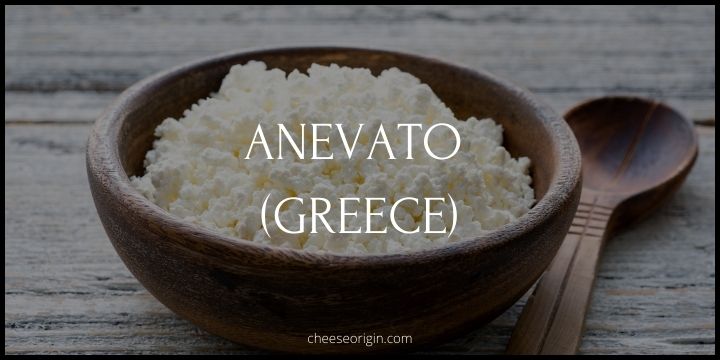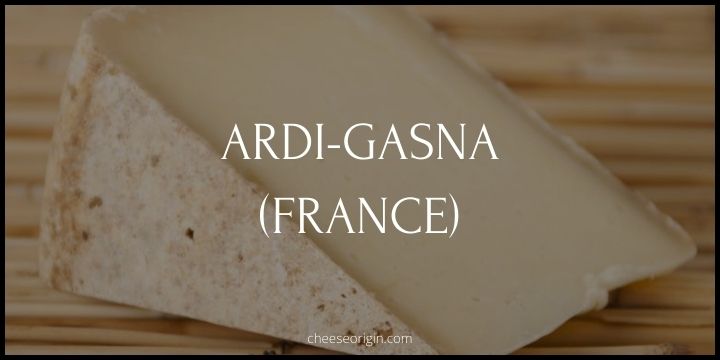What is Menonita? A Staple in Northern Mexican Cuisine
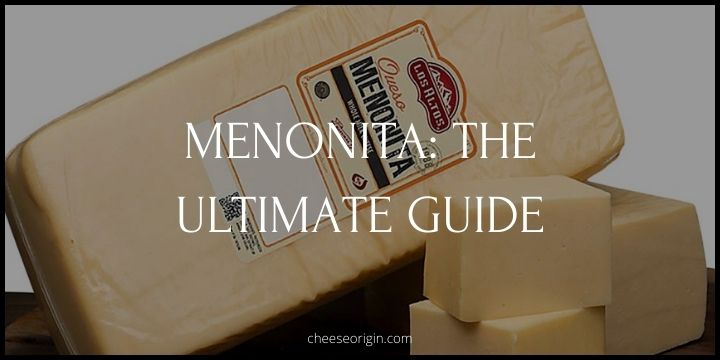
Welcome to the world of Menonita Cheese, a culinary treasure that has been gracing plates in Northern Mexico for generations. Often overshadowed by its more globally recognized siblings like Queso Fresco and Queso de Bola, Menonita Cheese has quietly carved out a niche for itself among cheese enthusiasts and food connoisseurs alike.
Named after the Mennonite communities of Chihuahua who first introduced it, this delightful dairy product is a testament to the influence of cultural exchange on cuisine.
In this post, we’ll traverse the rolling hills of Chihuahua and delve into the rich history, unique production process, and versatile applications of Menonita Cheese—a staple that adds a touch of creamy, mild flavor to the vibrant canvas of Northern Mexican cuisine.
Quick Facts About Menonita
| Quick Facts | Description |
|---|---|
| Origin | Mexico |
| Milk Source | Cow’s milk |
| Texture | Semi-hard to hard |
| Flavor | Mild, buttery |
| Color | Pale yellow |
| Aging Process | Aged for several months |
| Uses | Ideal for grating over dishes, melting in recipes, or eating on its own |
| Production Process | The curd is cut, drained, pressed, and then aged |
What kind of cheese is Menonita?
Menonita cheese, also known as queso menonita or queso Chihuahua, is a type of cheese that originated from the Mennonite communities in the Mexican state of Chihuahua. It’s a semi-soft cheese with a smooth texture and pale yellow color.
This cheese is typically made from cow’s milk and has a mild, buttery flavor similar to a mild cheddar or Monterey Jack. It’s known for its excellent melting qualities, making it a popular choice for dishes like quesadillas, enchiladas, and other Mexican cuisine.
The name “Menonita” comes from the Mennonite communities that began producing the cheese in the 1920s. These communities had emigrated from Canada and brought their cheese-making traditions with them, which they adapted to the local environment and resources in Mexico.
It should be noted that “Queso Chihuahua” sold in many supermarkets in the United States may not be true Menonita cheese, as the term is often used to refer to a variety of different semi-soft cheeses.
Authentic Menonita cheese is a specific product with a unique flavor profile and history.
What is Menonita cheese similar to? 7 best substitutes
| Cheese Substitute | Short Description |
|---|---|
| Mild Cheddar | Cheddar is one of the most famous cheeses worldwide and its mild variant offers a similar flavor profile to Menonita. It melts well and can be used in a variety of dishes. |
| Monterey Jack | This cheese is known for its creamy, mild flavor and excellent melting properties, making it a good substitute for Menonita. It’s also the base for other cheeses like Colby Jack and Cheddar Jack. |
| Muenster Cheese | Muenster cheese has a smooth texture and mild flavor that resembles Menonita. It’s a versatile cheese that works well in a range of dishes. |
| Oaxaca Cheese | Oaxaca cheese, also known as Queso Oaxaca, is a Mexican cheese with a string cheese-like texture. Its mild flavor and great melting qualities make it a suitable substitute for Menonita. |
| Mozzarella Cheese | Known for its superb melting qualities, Mozzarella can be used as a substitute for Menonita, especially in dishes where a smooth, creamy consistency is desired. |
| Queso Fresco | A fresh cheese from Mexico, Queso Fresco has a mild flavor and crumbly texture. While it doesn’t melt as smoothly, it can still be used as a substitute in some dishes. |
| Crema | While not a cheese, Crema is a Mexican dairy product similar to sour cream. It can be used as a substitute for Menonita in recipes where a tangy, creamy element is needed. |
What is Menonita cheese used for?
Menonita cheese is especially valued for its superb melting qualities. This makes it an excellent choice for a variety of dishes, particularly in Mexican cuisine.
Here are some common uses for this versatile cheese:
- Quesadillas: Menonita cheese melts beautifully, making it perfect for quesadillas. It creates a creamy, gooey filling that’s hard to resist.
- Enchiladas: This cheese can be used both inside enchiladas for a melty center and on top for a deliciously golden finish.
- Chiles Rellenos: Stuffed chili peppers often contain Menonita cheese, which provides a rich, creamy counterpoint to the spicy peppers.
- Fondue or Cheese Dips: Thanks to its excellent melting properties, Menonita cheese is a great choice for fondue or other cheese-based dips.
- Pizza Topping: While not traditional, Menonita cheese can be used as a topping on pizzas, where it will melt nicely and contribute a mild, creamy flavor.
- Grilled Cheese Sandwiches: For a twist on the classic sandwich, try using Menonita cheese. Its meltiness makes for a fantastic grilled cheese.
- Cheese Boards: Even though it’s a great melting cheese, Menonita can also stand alone. Try it on a cheese board with some fruit and crackers for a delightful snack.
What is Menonita cheese made of?
Menonita cheese is traditionally made from raw cow’s milk. The process of making Menonita cheese involves heating the milk and adding a starter culture to begin the fermentation process. Rennet, an enzyme that curdles milk, is then added to further solidify the mixture.
The curds are cut, heated, and stirred until they reach the desired consistency. They are then pressed to remove excess whey, and the resulting cheese is aged for a period of time to develop its flavor. Some variations of Menonita cheese may also be smoked or flavored with spices for added complexity.
Also read: The Science of Cheesemaking: A Journey from Milk to Artisanal Delight
Note: while traditional Menonita cheese is made with raw cow’s milk, many commercially available versions in places like the United States are made with pasteurized milk due to food safety regulations.
The 3 main ingredients in Memonita cheese:
- Cultured Pasteurized Milk or Unpasteurized Cow’s Milk: This is the primary ingredient. The milk can be either pasteurized (heat-treated to kill bacteria) or unpasteurized.
- Salt: Salt is added for flavor and also acts as a preservative.
- Enzymes: Enzymes such as rennet are added to cause the milk to curdle and form cheese.
Note: these are the basic ingredients. Some variations might include additional ingredients or spices for flavor. Also, always check the product label for specific ingredients, as they can vary by brand and recipe
How is Menonita cheese made?
Menonita aka Chihuahua cheese is made through a process that’s similar to many other types of cheese. Here is a general step-by-step breakdown:
- Preparation: The process begins with high-quality, full-fat cow’s milk. In traditional cheese-making, this would be raw milk, but many commercial producers use pasteurized milk for safety reasons.
- Culturing: A starter culture, which is a type of bacteria, is added to the milk. This culture begins to ferment the lactose in the milk, producing lactic acid.
- Curdling: Rennet, an enzyme typically derived from the stomachs of ruminant animals, is added to the milk. This causes the milk to coagulate and form curds.
- Cutting the Curd: The curds are cut into small pieces, a step that helps expel whey from the curd.
- Cooking and Stirring the Curd: The curds are gently heated and stirred. This process further expels whey and causes the curds to firm up.
- Draining and Pressing: The curds are drained of any remaining whey and then pressed to form a solid mass of cheese.
- Aging: The cheese is then aged for a period of time, which can range from a few weeks to several months. During this time, the cheese develops its characteristic flavor and texture.
- Packaging: Once the aging process is complete, the cheese is packaged and ready for sale.
What does Menonita Cheese taste like?
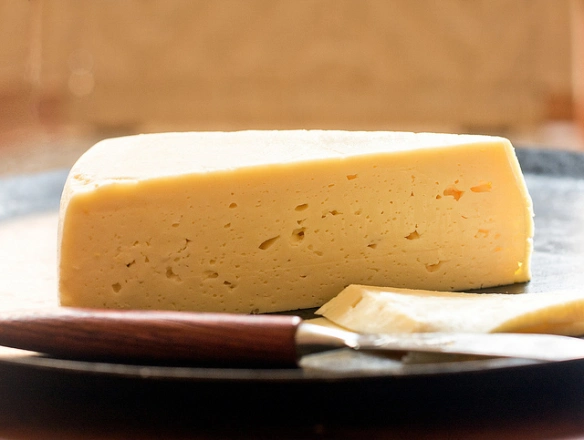
Queso Chihuahua is known for its mild, slightly salty, and creamy flavor. It has a buttery taste similar to a mild cheddar or Monterey Jack, with a hint of nuttiness.
The cheese’s flavor can become sharper when it is aged. Its soft and smooth texture makes it excellent for melting, which is why it is often used in dishes like quesadillas, enchiladas, and other Mexican cuisine.
Menonita Cheese tasting notes
- Appearance: Menonita cheese is pale yellow in color, often with a semi-soft to firm texture. It comes in a round or rectangular shape, depending on how it’s been aged.
- Texture: The cheese has a smooth and creamy texture. When young, it’s semi-soft and becomes firmer with age. It’s not crumbly, rather it has a supple quality that allows it to melt beautifully.
- Flavor: Menonita cheese is known for its mild, slightly salty, and creamy flavor. It has a buttery taste similar to a mild cheddar or Monterey Jack. As the cheese ages, it may develop a sharper, more pronounced flavor.
- Aroma: The cheese has a mild, milky aroma with a hint of buttery notes.
- Pairings: Due to its versatile flavor profile, Menonita cheese pairs well with a variety of foods. It’s excellent in Mexican dishes like quesadillas and enchiladas. It also complements fruits like apples and grapes, and goes well with a glass of white wine or light beer.
Also read: What Fruit Goes on a Charcuterie Board?
Is Menonita Cheese healthy?
Yes, Menonita cheese can be considered healthy when consumed in moderation as part of a balanced diet. It is a great low-carb source of calcium and protein. However, like many cheeses, it can also be high in calories and sodium, so it should be consumed in moderation.
Menonita contains 110 calories per serving, and it has been given a nutrition grade of B. This means it has a fairly balanced ratio of beneficial to potentially harmful ingredients.
The cheese is rich in phosphorus, which plays a vital role in the formation of bones and teeth, and it’s a good source of calcium, which is essential for bone health. Menonita cheese also provides a decent amount of protein, necessary for muscle repair and growth.
However, it’s important to note that Menonita cheese can also contain a high amount of fat. One ounce of Menonita cheese contains around 8-9 grams of fat.
Like any other food, the healthiness of Menonita cheese ultimately depends on how it fits into your overall diet. If you’re watching your calorie or sodium intake, you’ll want to enjoy it in moderation.
Menonita Cheese nutrition facts
| Nutrient | Amount (per 1 oz serving) |
|---|---|
| Calories | 100 – 110 |
| Total Fat | 8 – 9g |
| Saturated Fat | 5g |
| Protein | Varies |
| Sodium | Varies |
| Calcium | Good source |
| Phosphorus | Good source |
Where to buy Menonita Cheese?
What goes well with Menonita Cheese
Food that goes well with Menonita Cheese
| Category | Food Pairing for Menonita Cheese |
|---|---|
| Mexican Dishes | Enchiladas, Chiles Rellenos |
| Cheese Dishes | Queso Fundido, Cheese Nachos |
| Baked Foods | Casseroles, Baked Ziti |
| Pizza & Pasta | Margherita Pizza, Pasta Alfredo |
| Sandwiches & Burgers | Cheeseburgers, Grilled Cheese |
| Salads | Cobb Salad, Caesar Salad |
| Snacks | Cheese Boards, Cheese Popcorn |
Also read: What is the Best Cheese for Pizza?
Beverage that goes well with Menonita Cheese
| Category | Beverage Pairing for Menonita Cheese |
|---|---|
| Wine | Chardonnay, Pinot Noir |
| Beer | Lager, Pilsner |
| Spirits & Cocktails | Tequila, Margaritas |
| Non-Alcoholic Drinks | Apple Cider, Grape Juice |
Also read: Best Wine and Cheese Pairings: The Ultimate Guide
The History of Menonita cheese
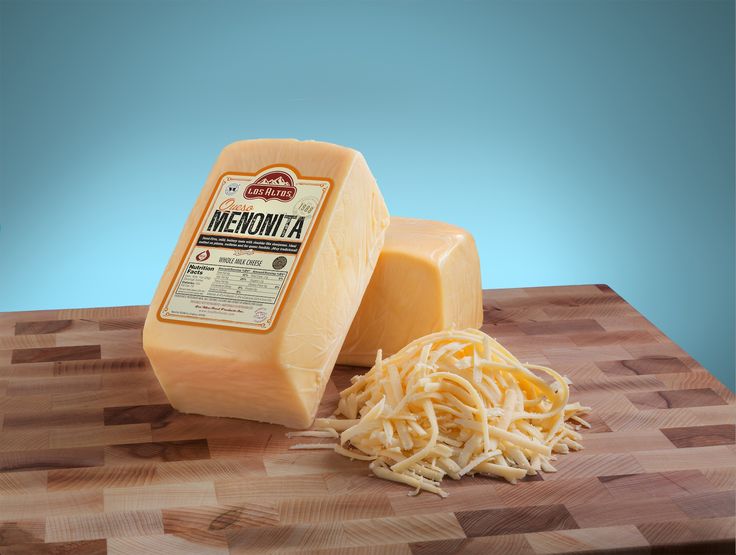
Menonita cheese, also known as Queso Chihuahua, originated in the northern region of Mexico. The cheese is named after the Mennonite communities that first produced it. These communities, comprised of people of Dutch descent, have been living in the Chihuahua region since the 1920s.
This traditional Mexican cheese was initially produced during the colonial period. It’s made from either pasteurized or unpasteurized cow’s milk and belongs to the Cheddar family. The cheese is semi-soft and has a fat content of about 51-55%.
Menonita cheese is characterized by its pale yellow color and semi-firm texture. Its flavor is mild, with a buttery taste and a cheddar-like sharpness. This makes it ideal for melting on pizzas, molletes, and queso fundido.
While the Mennonites were the initial producers of this cheese, it’s now made by various companies and is sold all across Mexico. In fact, it’s common to see Mennonite men selling their delicious cheese at major intersections in several of Mexico’s major cities.
Why is it called Chihuahua cheese?
Chihuahua cheese is named after the region and the community where it originated. The cheese was first made in the northern Mexican state of Chihuahua, which lends its name to the cheese.
The alternative name, Queso Menonita, comes from the Mennonite farmers who were the original producers of this cheese. These Mennonite communities have lived in the Chihuahua region since the 1920s and began producing this type of cheese during that time.
Final Thoughts
Menonita cheese is more than just a dairy product; it’s an embodiment of cultural heritage and tradition in northern Mexico. Its origins in the Mennonite communities of the 1920s have shaped its unique characteristics, making it a beloved ingredient in the region’s cuisine.
The cheese’s versatile profile, with its mild, buttery flavor and excellent melting properties, has solidified its place in a variety of Mexican dishes.
As it continues to be produced and enjoyed by people all over Mexico and beyond, Menonita cheese stands as a testament to the rich culinary tapestry of the country, demonstrating how food can tell the story of a community’s history and way of life.
Also read:
- Discovering Panela: A Guide to Mexico’s Versatile Cheese
- All About Swiss Cheese: A Comprehensive Guide
- The Ultimate Guide to Bocconcini: From Origin to Plate
- The Ultimate Guide to Muenster Cheese: Savor the Flavor
- The Ultimate Guide to Hoop Cheese: A Southern Delight
- The Ultimate Guide to Chèvre: Exploring Goat Cheese
- The Ultimate Guide to Kasseri: A Taste of Tradition



